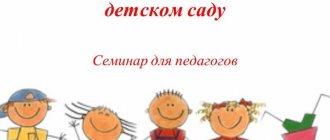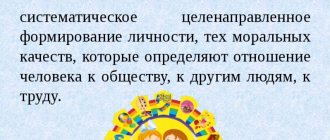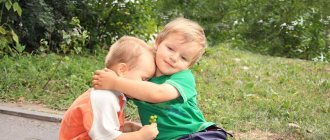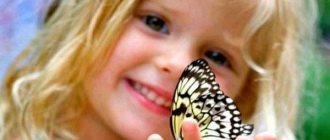Master Class
MBDU "Kadoshkinsky combined kindergarten "Teremok"
Master class on the topic:
"Education of morality in children."
Completed by: Nikulina R.A.
Teacher of the 1st category.
Kadoshkino
target :
Improving the work on moral education of preschoolers in preschool educational institutions.
Tasks:
1. To increase the knowledge, professional competence, and pedagogical skills of educators in implementing the tasks of moral education.
2.Develop the ability to discuss and agree on proposed issues and tasks. Develop the creative activity of participants.
Materials and equipment:
Hand layouts, syncwine rules, aphorisms, proverbs, task cards, pens, markers.
Progress of the master class:
Good afternoon, dear colleagues!
Today, the education of spiritual and moral values in preschoolers is one of the priority tasks of the educational system at all its levels.
Childhood is the time of development of all human powers: both spiritual and physical, the time of acquiring knowledge about the world around us, the time of formation of moral skills and habits. In the preschool period, there is an active accumulation of moral experience, self-determination and the formation of self-awareness.
Of course, you need to start working on spiritual and moral education by creating a warm, cozy atmosphere for children. Every child in kindergarten should be filled with joy, smiles, good friends, and fun games. After all, with the cultivation of a feeling of attachment to one’s own kindergarten, one’s own street, one’s own family, the formation of the foundation on which a more complex moral sense will grow begins.
In the yard, forgetting about shame, a bad word lies -
Not on a stump, not on a bench, not in a birdhouse, not in a watering can,
Not on the grass, not in the sand, but in the mouth, on the tongue.
The boy Vova walks and wanders, sowing this word everywhere,
And for his sin, a big angel cries behind his back.
Dear Colleagues! Try to answer the question: “What is spiritual and moral education?” (answers, 2 is enough).
Thank you, colleagues!
Spiritual and moral education is understood as a purposeful activity aimed at the gradual restoration of the holistic structure of the individual, a person’s self-determination and his improvement.
I believe that the basis of spiritual and moral education, first of all, is the spiritual culture of the environment in which the child lives, in which his formation and development takes place - this is the spiritual culture of the family, kindergarten, school.
Today I want to offer you several tasks on the topic of our master class. But first, I suggest you play the game “Kind Words”.
Extracurricular activity on moral education, 5th grade
Summary of an extracurricular activity for schoolchildren “Teach your heart to be good”
Goal: to form in children a value orientation and the ability to formulate moral judgments. Objectives: Educational:
determine the essence of the concept of “kindness”, the qualities of a kind, respectful and merciful attitude towards each other.
Developmental:
- reveal the positive aspects of kindness;
- encourage sensitivity to adults and peers; - develop the ability to distinguish bad from good. Educational:
- to cultivate kindness and mercy in children;
- to form the concept of universal human values, to observe the principles of morality and morality. - educate children to respect each other. Correctional:
correction of the emotional-volitional sphere based on the development of communication skills.
Basic universal actions: Personal:
establish a connection between the goal of educational activity and its motive;
evaluate the content being learned (based on personal values); establish a connection between the purpose of an activity and its result. Regulatory:
express your assumption based on the educational material;
distinguish a correctly completed task from an incorrect one; exercise self-control. Cognitive:
navigate your knowledge system;
analyze objects; transform information from one form to another. Communicative:
listening and understanding the speech of others;
express your thoughts orally; be able to formulate your own opinion. Methods: verbal (conversation, verbal-problem method); visual (methods of illustrating slides); problem-search (solving a problem in the form of a discussion); method of forming cognitive interest (activating attention during repetition); method of independent activity of children. Equipment: presentation, pedagogical situations, musical accompaniment, interactive whiteboard, video “Gem Flower”, “Day of Good Deeds”, handouts for the practical part.
Progress of the lesson
I. Introductory conversation. — Dear guys, dear guests! May today’s activity bring us the joy of communication and fill our souls with wonderful feelings. I want our lesson from the words of L. Tatyanicheva, “To do good for people is to make yourself look good.” (Slide 1)
- Guys, how do you understand this expression?
(Children's answers)
.
Today at our event we will talk to you about what no person can do without in their life. What is this? To do this, you must unravel the word that is written on the board. - Pay attention to the screen, here are the syllables from which you need to make up a key word, which you must guess, and we need it in life. Tabrodo (Slide 2)
Kindness
(Slide 3) II. Main part. - And so the theme of our lesson is “Teach your heart to be kind.” (Slide 4)
.
And the epigraph of our lesson will be the words of L.N. Tolstoy “To believe in good, you need to do it” (Slide 5)
.
- Guys, what is good? (Children's answers)
.
1. Discussion of the parable. (calm music sounds with illustrations shown) (Slide 6-10)
.
“This story happened a long time ago in an ancient city where a great sage lived. The fame of his wisdom spread far around his hometown. But there was a man in the city who was jealous of his fame. And so he decided to come up with a question so that the sage would not be able to answer it. And he went to the meadow, caught a butterfly, planted it between his closed palms and thought: “Let me ask the sage, which butterfly is in my hands - alive or dead? If he says - alive, I will close my palms and the butterfly will die, and if he says dead, I will open my palms and the butterfly will fly away. Then everyone will understand which of us is smarter.” The envious man caught a butterfly, planted it between his palms and went to the sage. And he asked him: “Which butterfly is in my hands, oh wise one: alive or dead? And then the sage, who really was a very smart man, said: “Everything is in your hands.” Questions for discussion. - How do you feel about this person? — How would you answer if you were an envious person? — How do you understand the words of the sage “Everything is in your hands”? - Well done. Guys, pay attention to screen 2. “Good deeds make a person beautiful” (Slide 11)
Questions for discussion.
- Does this proverb fit our parable? - How do you understand this proverb? (Children's answers)
- Yes, guys, there are values in life, without which there is no life on Earth.
Pay attention to the screen. Assignment: from the list of words, select the qualities of a kind, good, positive person
.
(Slide 12)
Kind and compassionate Envious Honest Noble Evil Responsible Soulful and friendly Good-natured, smart, beautiful Worthy Greedy.
— The qualities you mentioned are not innate, they must be cultivated. We can name many positive qualities of a person, but we put kindness first. -Why do we put kindness first? (Children's answers)
.
“When man appeared, he was awarded reason, speech, the ability to master and art. Man began to get food, get beautiful things, and build houses. But what a person is like inside, everything depends only on his heart and soul. If the soul is kind, then everything will be fine in life. - Guys, what does a kind person mean? (Children's answers)
.
III. Physical exercise. (Slide 13)
- Guys, today we are talking about kindness.
We create a good mood. I suggest you turn to each other and smile. III. Working with Ozhegov's explanatory dictionary. (Slide 14)
Kindness is responsiveness, emotional disposition towards people, the desire to do good to others.
Questions for discussion. (Slide 15)
- Guys, kindness makes a person what kind of person?
— Give examples of people’s kind attitude? (Children's answers)
.
IV. Watching the video “Day of Good Deeds” followed by discussion V. Corrective and developmental exercise “Smile” (Slide 16)
- Guys, what do you think is the first step to good relationships with people?
Our exercise will help us with this. Task: put the words back in their place and get the answer. VI. Situational workshop. - Imagine that your offender fell into an ice hole. There is no one around except you. No one hears his cry for help. What will you do in this situation? 1. will you pass by 2. will you try to help him? – Is it possible to force a person to be kind? – If you know how to forgive, can this be considered the beginning of a good relationship? – What wins more often, good or evil? (Children's answers)
- In fairy tales, good always wins, but life is not a fairy tale.
Anything can happen in life... Reading the parable “A hunter was walking through the forest, suddenly he saw: a tree fell on the road and crushed a snake. The hunter approached the snake, and it begged him: “Save me, I’ve been lying here for two days now, dying, lift the tree.” The hunter lifted the tree, the snake slithered out, wrapped itself around the hunter's leg and prepared to bite him. The hunter begged: “What are you doing, I saved you from death?” “That’s why I’m a snake,” she replies. Here, fortunately for the hunter, a fox runs by. The hunter asks the fox to judge which of them is right. But the fox pretended that he didn’t understand anything and asked the snake to lie down again under the tree. The hunter crushed the snake with a tree and did not save any more; he went his way, leaving the snake to die.” - So maybe you shouldn’t do good? And live by the proverb “If you don’t do good, you won’t get evil” - When you meet a person on the street, can you immediately tell whether he is good or evil? (You can judge a person by his deeds; you can say many times that you feel sorry for old people, and never give up your seat on the bus; verbally care about nature, without noticing the trash can)
.
VII. Corrective and developmental exercise “Collect a proverb” (Slide 17)
• Life is given for ......
(good deeds)
• The evil one does not believe that there is .....
(kind)
• A kind word .....
(kind answer)
• Good everywhere ......
(good)
• To live with kindness……..
(good)
.
VIII. Practical part - Guys, let's go back to the epigraph of our lesson “To believe in good, you need to start doing it” L.N. Tolstoy (Slide18)
.
“It’s more pleasant for us to be in the company of kind people, but for this we must be kind people ourselves.” Let's make rules of kindness with you, using which we will become truly kind. Assignment: from the list of mixed up words that are written on the screen, you need to create rules of kindness. (Slide 19)
1) Help people.
2) Protect the weak. 3) Share the latter with a friend. 4) Don't be jealous. 5) Forgive others' mistakes. IX. Summary of the lesson. (Slide 20)
. — At the end of our lesson, I would like to remember Valentin Kataev’s fairy tale “The Flower of Seven Flowers” about the kind girl Zhenya, who received a magical flower with transparent petals of different colors as a gift. By casting spells and tearing off one petal, Zhenechka could make any wish, and it would immediately come true. And when she had the last petal left, she found a new friend, who, to her great regret, could not play tag with her, because... was lame. And then for the first time Zhenya made a wish not for herself. “I suggest you write on the only petal on your desk a wish, the fulfillment of which would help not only you personally, but also someone else.” Good hearts are gardens. Kind words are roots. Good thoughts are flowers. Good deeds are fruits. So take care of your garden and do not let it become overgrown with weeds, fill it with sunshine, kind words, thoughts and good deeds.
We recommend watching:
Tournament "Funny Colors" for children in grades 5-7. Scenario
Scenario of an educational and entertaining event for children 9-12 years old Summary of an extracurricular activity in grades 5-6 on the topic: Good and bad habits Educational event for grades 5-8 on the topic: Proper nutrition
Similar articles:
Scenario of extracurricular activities for grades 3, 4, 5. Cruise







